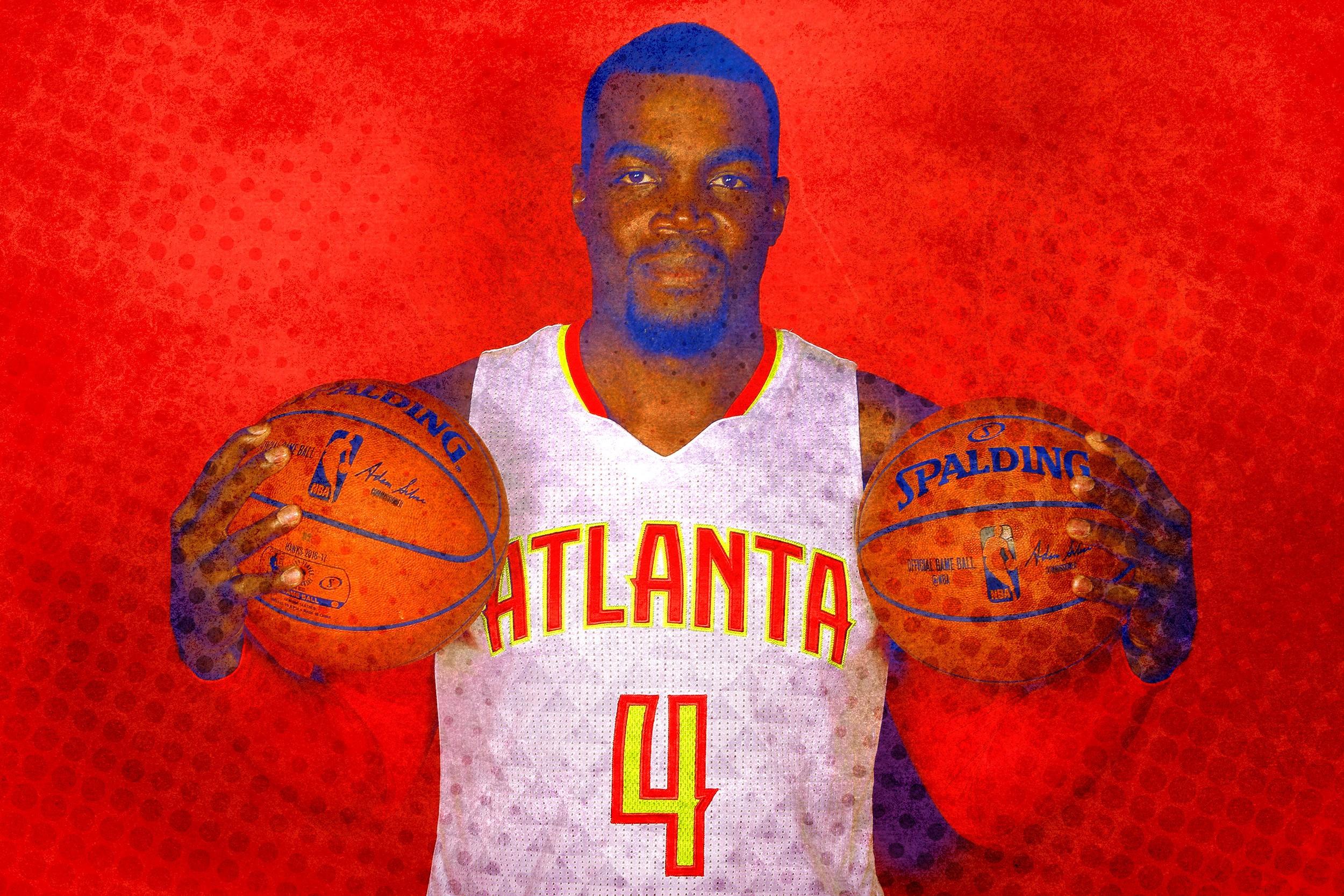
It was just one night in early November, but the Hawks’ seventh game of the season carried a psychological burden. Prior to Atlanta’s 110–106 victory over Cleveland on Tuesday, it was staring at an 11-game losing streak to the Cavaliers in the span of just under one full calendar year — three regular-season losses sandwiched by two consecutive postseason sweeps at the hands of LeBron James and Co. More so than any other Eastern Conference also-ran in the shadow of James’s long trail of dominance, the Hawks can be defined specifically by their inability to shake LeBron. Atlanta’s team identity over the past few seasons, built on spacing and aggressive team defense, has been as strong as any in the league, but its DNA changes sequence against LeBron; it becomes unwound. On Tuesday, the Hawks used a different look and approach. It worked. We can chalk that up to it being one night in early November, but desperation is the greatest agent of change.
Before the game, Hawks coach Mike Budenholzer downplayed just how haunted his guys have been by LeBron and the Cavaliers. “If you spend too much time obsessing about a team or a player, you may not ever even play that team or that player in the playoffs,” Budenholzer told The Atlanta Journal-Constitution. “You just have to put together the best team possible with as many good players as possible and that is what is going to give you your best chance. You make a mistake chasing something that is that specific.”
This is a perfectly reasonable thing to say about a team in a league of 30, wherein each, just before the ball is tipped, conceivably has a 50–50 chance of winning — wherein teams rarely have the power to determine postseason matchups. But life imitates art through metaphor: With 2:11 remaining in the third quarter Tuesday night, the Hawks found themselves in a 1-on-5 situation trying to defend LeBron in the fast break. Consider this a physical rejoinder to Budenholzer’s comments:
The Hawks were given a face-lift during the offseason, whether it was a direct response to the threat of LeBron or not. In swapping out Al Horford for Dwight Howard, part of the Hawks’ core identity was fundamentally altered. Having a frontcourt of Horford and Paul Millsap meant the Hawks were best suited leveraging their quickness up front. In lieu of traditional rim protection, they would blitz pick-and-rolls, crowd the ball, and trap. It was an exercise in discipline and chemistry; every defensive possession was its own trust fall. That frantic style of defense only works if all five men on that side of the ball are committed. But when the gears begin to wear down and you’re staring back at a wholly superior opponent, it’s nearly impossible to sustain at the level required to win out against a championship contender.
Bringing in Howard meant that Atlanta’s base pick-and-roll philosophy would have to change. Instead of protecting the painted area by having the entire team swarm and recover, the Hawks have allowed Dwight to do what he’s done well his entire career: drop back and single-handedly patrol the paint. Because of how blitzing drew frontline defenders away from the basket, the Hawks of the Horford-Budenholzer mini-era consistently ranked among the worst defensive rebounding teams in the league. During matchups with Cleveland, that played right into the Cavs’ hands. Tristan Thompson is one of the three best offensive rebounders in basketball, and in last season’s second-round sweep he averaged more offensive rebounds (six) than defensive rebounds (five) per game. The Cavs shot the 3 at historic rates in that series; when they missed, they revived possessions at an abnormal clip for another go at it.
If there was any immediate course corrective following the Hawks’ second straight embarrassment at the hands of Cleveland, addressing the rebounding issue was it. They were able to snag only 46.3 percent of the rebounds in that series against the Cavs, and their 69 percent defensive rebounding percentage was more than 5.5 points lower than their regular-season figure. By installing an elite rim protector on defense, the Hawks have recommitted themselves to the defensive glass, while lessening the amount of wear their perimeter players have to endure on the defensive end. Budenholzer might not admit it, but acquiring Dwight was very much a decision made to negate the glaring advantages that Cleveland waved in the face of Atlanta.
So far, so good. The Hawks are 5–2, with a win over the champs in the books. Atlanta was the best defensive team in the league once the calendar rolled over to 2016 last season, and it’s been no less impressive this fall, holding teams to 95.3 points per 100 possessions, a top-five mark. What’s changed is now it’s a top-five rebounding team, too. The Hawks still show glimpses of their old mode of play — Millsap has been slotted at the 5 at times this season as a curveball, and those lineups rely on Millsap to stay in front of his man and long, athletic wings like Thabo Sefolosha and Kent Bazemore to help cover him — but the addition of Dwight allows the team to dial back the intensity without sacrificing results. The Hawks now have a true anchor down in the paint; as such, Howard has lifted some of the burden from the team’s group-oriented defense.
One of the more encouraging things to take away from the Hawks’ win on Tuesday was Howard’s demeanor on the floor. He attempted only five shots in the game, making three, and took four free throws. He was targeted on a few lobs in the pick-and-roll, but the offensive game plan wasn’t ceded to him. He looked secure in his dominance, even though it didn’t manifest in the points column. Howard had 17 rebounds, 15 on the defensive end, and completely eclipsed Thompson, who had two rebounds on the game, neither on the offensive glass. Howard was another face in the crowd, doing his job and doing it well. This isn’t his team.

What does it mean to have a team built in the image of a player when that player is faceless? Horford’s departure means that, at least for now, Millsap has become the team’s overarching leader. He’s a player who, if you don’t watch a lot of Hawks basketball, can be difficult to appreciate. He does so much on the court that it strangely can appear as though he isn’t doing anything at all. He is Atlanta’s best scorer and best defender, but his accomplishments on both ends betray no stylistic intrigue. Even in the phylum of cold, stoic stars, he is not Kawhi Leonard, who glides around with ease and whose puppet master, Gregg Popovich, serves as a kind of bizarro Lil Penny figure. Millsap is just plain really good — LeBron, but cut from limestone instead of marble.
In the first seven games, Millsap has gone through the trials that come with being a first-time first option. His usage rate is up, and so is his turnover percentage; he is shooting the ball at a career-low 43.5 percent. He’s figuring out when to set up his teammates and when to take over the offense. It’s tough water to navigate for any emergent star, let alone a 31-year-old who has spent the bulk of his 10 years in the league as a complementary player. He’s yet to dominate a game in a traditional sense, but among Hawks starters his 12.4 net rating through seven games is by far the best.
He serves as a safety valve in so many areas. With Dennis Schröder also working out the kinks of his new role as the lead point guard on the team, Millsap has stepped in and become a secondary and tertiary ball handler, posting a career-high assist rate and looking more and more comfortable setting people up from the perimeter. With Howard on the floor, teams have no choice but to stick their biggest player on him, leaving Millsap to overpower defenders on the strong side when they clear things out for him on the block.
So far it’s been effective, but the team, like Millsap himself, isn’t going to dazzle anyone. Atlanta’s games are ugly, and messy, and a far cry from its two-month Joga Bonito simulacra from 2014–15, which has gotten only increasingly strange in hindsight. The ball doesn’t move from side to side the way it once did, which is fine, but the increased ball-pounding has also turned the Hawks into one of the most turnover-prone teams in the league. Atlanta dominated the glass against Cleveland, shot over 50 percent from the field, and allowed the Cavs to shoot only 37.4 percent. It also turned the ball over 19 times, though, effectively neutralizing its advantage on the boards. The Cavs attempted 18 more shots than the Hawks did, and went 11-for-42 (42!) from behind the arc. The Hawks brought home a very important win, but they were lucky to have turned the ball over that many times against the defending champs and survived. They proved that they’ve patched up a few of their most glaring weaknesses of the past two seasons, but their inability to keep the Cavs off the 3-point line Tuesday was a legitimate concern. Should the two teams meet in the playoffs for the third consecutive time, it wouldn’t be hard to see Atlanta falling into the same traps of yesteryear.
That’s still a ways away, but things are looking good in early November. There is a continuity that persists through this Atlanta roster, and a lot of credit goes to Budenholzer for maintaining the through line. The Hawks look no worse than they did last year. That’s a relief for fans; those Hawks were really good. But the specter of LeBron is enough to change a team. Reading into quotes from the locker room, it’s clear that players have taken notice. “It’s a different look,” Bazemore said after the Cavs game. “We are playing super confident. We believe we can beat them.”
Things are different, but maybe not different enough.

